Inner Solar System
The Earth
Earth Structure
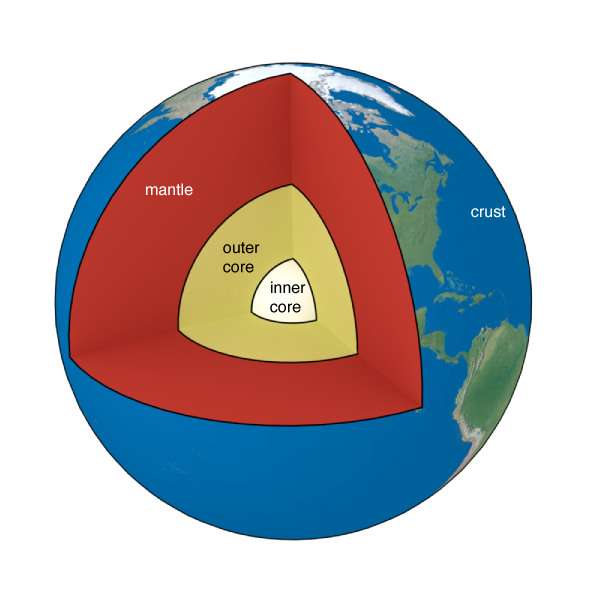
A schematic drawing of the major sections inside the earth
| Region | Thickness | Constituents |
|---|---|---|
| Inner core | 1300 km | Solid Iron & Nickel |
| Outer core | 2250 km | Liquid Iron & Nickel |
| Mantle | 2900 km | Rocky (heavy elements) |
| Crust | 8-40 km | Rocky (lighter elements) |
| Atmosphere | 16 - 480 km | Gasses |
Earth Atmosphere
| Fraction (by mass) | Fraction (by number) | Species |
|---|---|---|
| 75.5 % | 78.1 % | N2 |
| 23.1 % | 20.9 % | O2 |
| 1.3 % | 0.93 % | Ar |
| 0.05 % | 0.04 % | CO2 |
| trace | trace | Ne, He, CH4, Neon, He, Methane, Krypton |
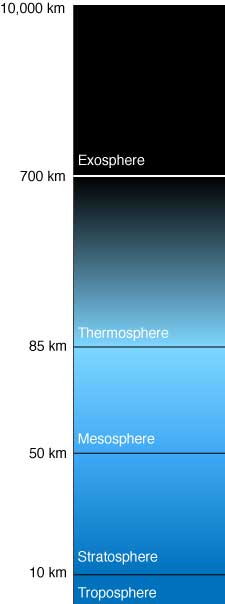
The Atmosphere of the Earth
Earth Magnetosphere
Origins of the Magnetosphere

Simulation of the geo-dynamo fields
Contemporary Physics, 1997, 38 4, Glatzmaier, G. and Roberts, P. http://dx.doi.org/10.1080/001075197182351
The Dynamo Theory: Moving charges.
- Why is the Earth magnetic?
- Why has its magnetic field existed over at least 70% of geological time?
- Why is it predominantly dipolar?
- What determines its strength?
- Why does its strength vary, but by so little?
- Why does the magnetic compass needle point approximately North?
- Why does the averaged geomagnetic axis coincide with the geographical axis?
- Why does the polarity of the Earth’s field reverse?
- What happens to the geomagnetic field during a reversal and why?
- Why does the frequency of reversals vary so greatly over geological time?
- Why is neither polarity of field favored over the other?
- What causes the slow secular change of the field?
- What is the significance of the westward drift?
- Can a single mechanism explain why other planets and satellites are magnetic too?
The Earth's Magnetic field
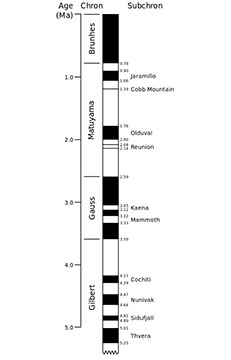
Magnetic field flips
USGS
Strength: 25 to 65 microteslas (0.25 to 0.65 gauss).
The north magnetic pole is in Greenland
It flips sometimes. (Last time was about 780,000 years ago.)
What does it do?
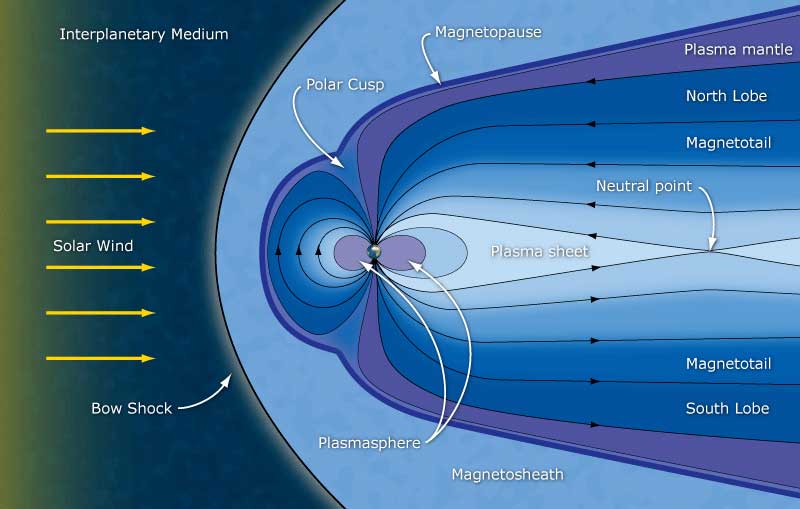
Illustration of Earth's magnetic field
ESA/C. T. Russel
Van Allen Radiation Belts

Van Allen Probes
Johns Hopkins University Applied Physics Laboratory
Van Allen Probe - Science Overview
Van Allen Probe - Instruments
Earth's shape
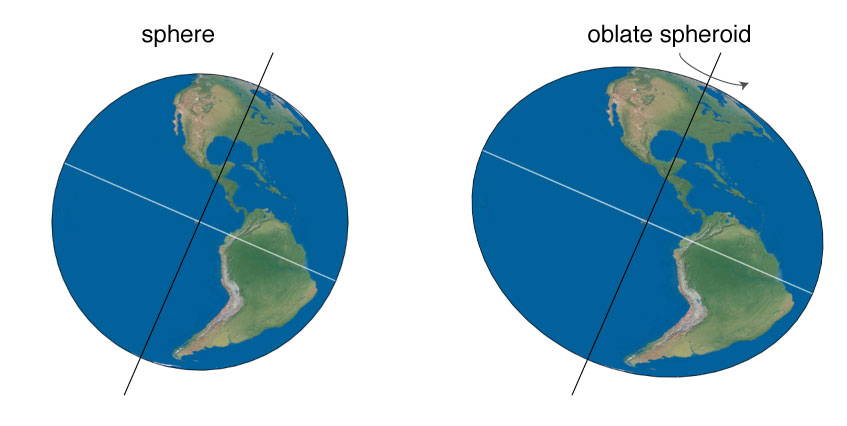
Precession
The spheroid allows for a torque, which leads to a precession.
Precession
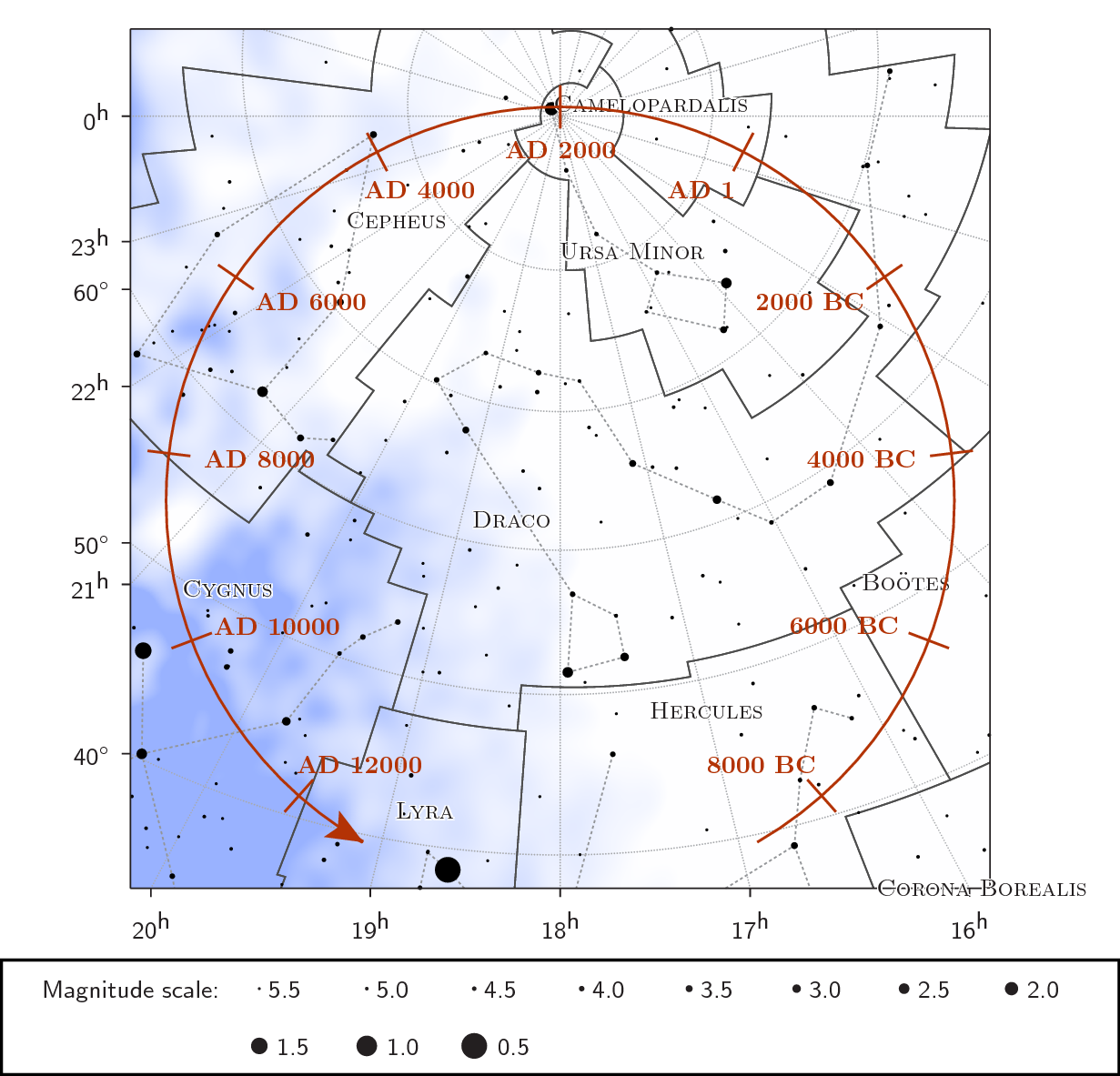
The North Celestial Pole
https://in-the-sky.org/article.php?term=precession_of_the_equinoxes
The North Pole Star changes! Just very slowly.
The Moon
Moon Structure
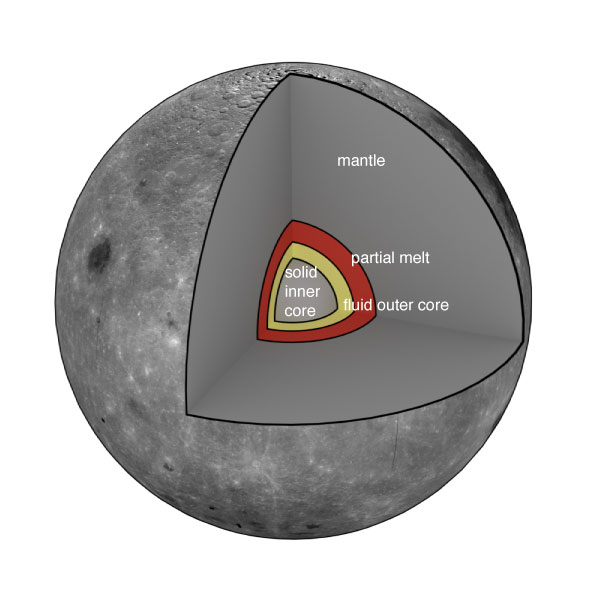
Lunar internal structure
Formation

Moon Formation
By NASA/JPL-Caltech - http://www.nasa.gov/multimedia/imagegallery/image_feature_1454.html, Public Domain, https://commons.wikimedia.org/w/index.php?curid=8626942
Giant-impact hypothesis
- Earth's spin and moon's orbit have similar orientations
- Moon samples indicate that the Moon's surface was once molten.
- The Moon has a relatively small iron core.
- The Moon has a lower density than Earth.
- Evidence exists of similar collisions in other star systems (that result in debris disks).
- The stable-isotope ratios of lunar and terrestrial rock are identical, implying a common origin.
Explorations
First Touch
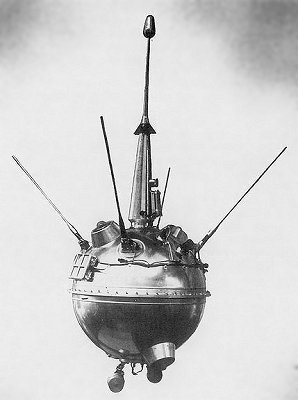
Luna 2: Soviet Moon Probe, September 12, 1959
By NASA - http://nssdc.gsfc.nasa.gov/database/MasterCatalog?sc=1959-014A, Public Domain, https://commons.wikimedia.org/w/index.php?curid=16509292
Apollo Program
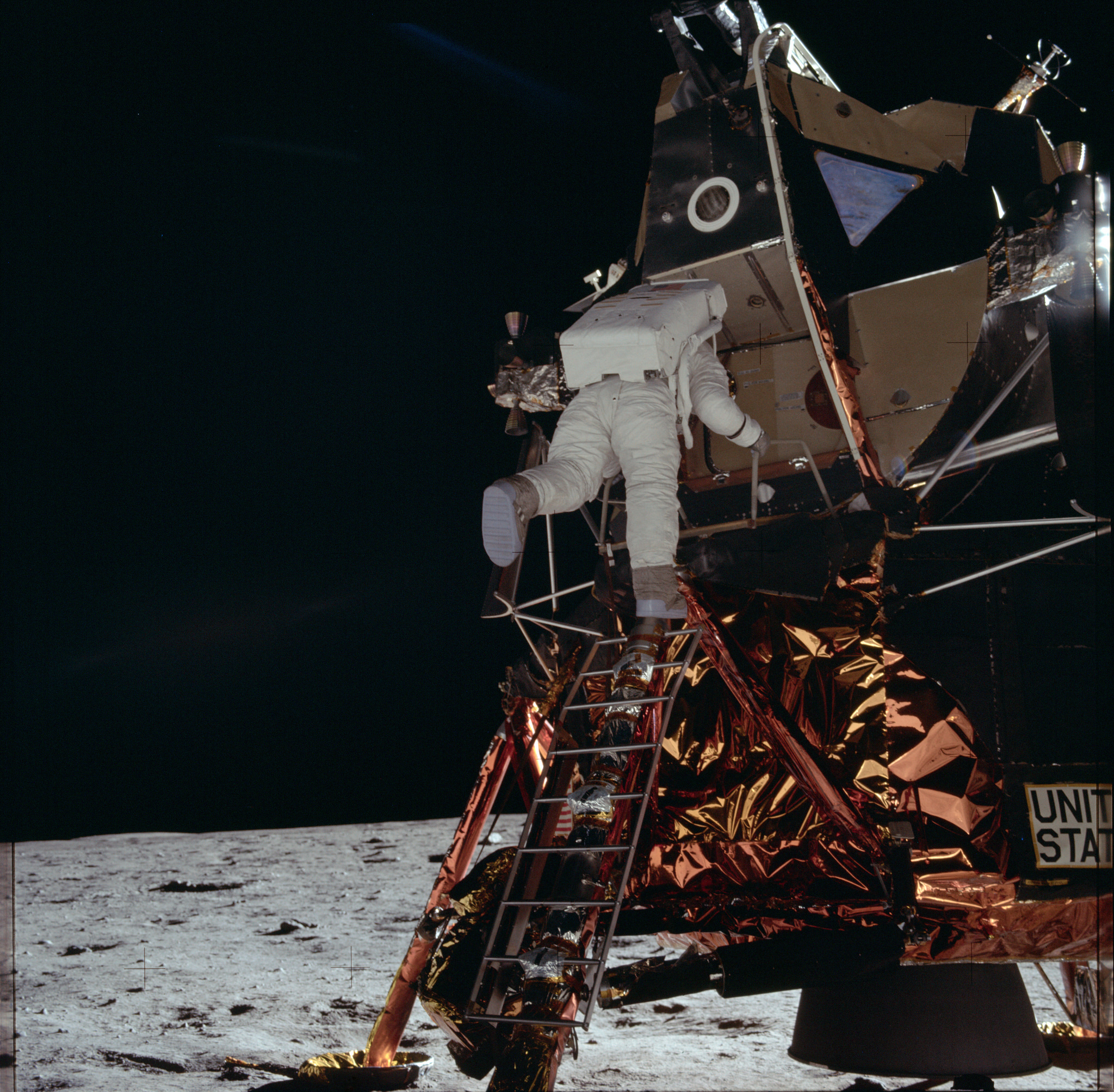
On the lunar surface
NASA: flickr album
- 1961 to 1972
- First manned flight: 1968
- First landing: Apollo 11, July 1969
- Last landing: Apollo 17, Dec 1972
- Missions brought back 842 lbs of rocks
- Left several science experiments
- Installed Retro-Reflectors
Earth Moon System
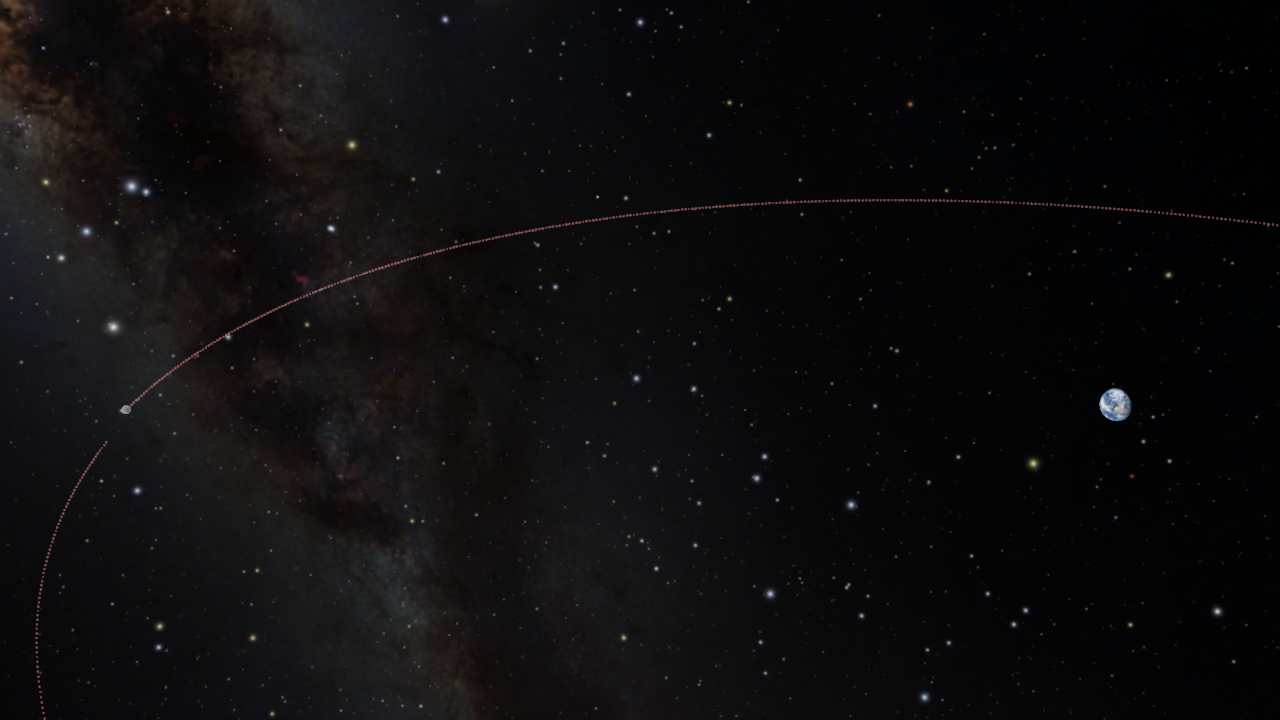
Scale Image of Earth and Moon
Tides
Tidal Locking
A torque will arise if the two angular velocities are different, due to the tidal bulge.
Moon is leaving
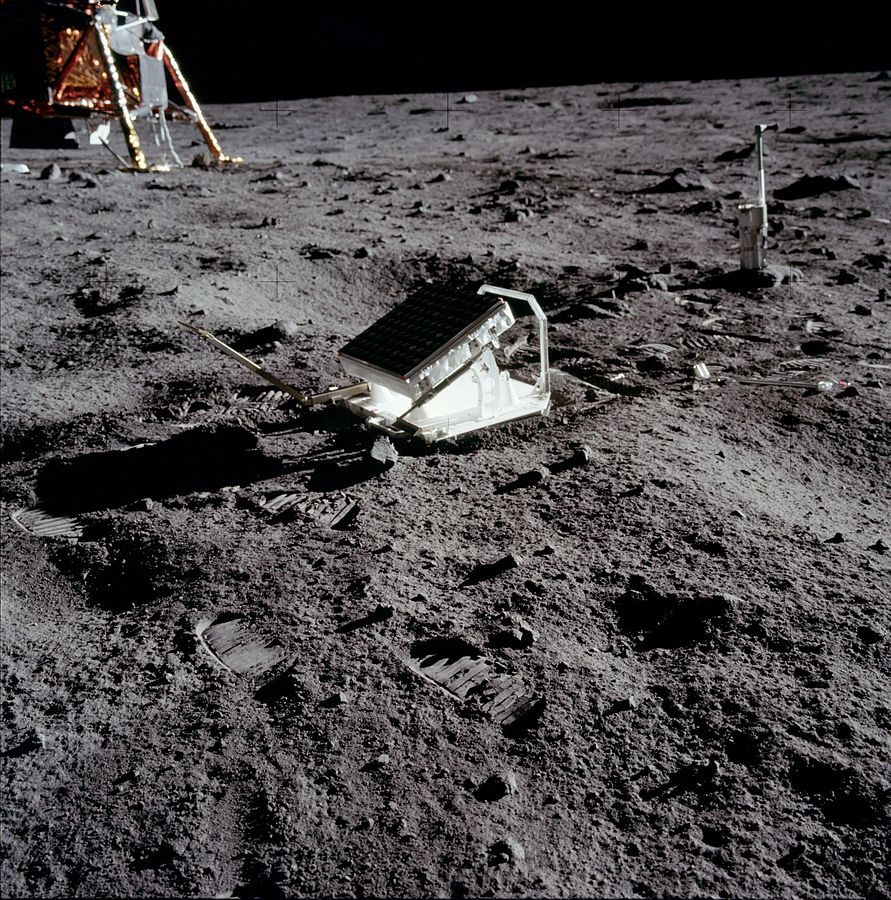
Lunar Laser Ranging Experiment with the stereo camera in the background (NASA image number AS11-40-5952). This Retroreflector was left on the Moon by astronauts on the Apollo 11 mission. Astronomers all over the world have reflected laser light off the reflectors to measure precisely the Earth-Moon distance.
3.8 cm/year
Tidal Braking
Tidal Braking
Over time, the tidal bulge will create a counter-torque to the rotation. This will cause the central object to rotate just a little bit slower. We can measure this: $$\begin{equation} \frac{dP_\textrm{rot}}{dt} = 0.0016 \; \textrm{s} / \; \textrm{century} \end{equation}$$ But this implies a change in $L$! Where does it go?
Let's start with the angular momentum $L$ of the moon in orbit around the earth. It depends on the mass of the moon, its speed and its distance from the center of rotation. $$\begin{equation} L_\textrm{orbit} = M_\textrm{moon} v r = M_\textrm{moon}\left( \frac{G M_\textrm{E} }{r}\right)^{(1/2)}r = \left( G M_\textrm{E} M_\textrm{moon}^2 r\right)^{(1/2)} \end{equation}$$ Consider the change in angular momentum as a function of time: $$\begin{equation} \frac{dL_\textrm{orbit}}{dt} = \left(G M_\textrm{E} M_\textrm{moon}^2\right)^{(1/2)}\frac{1}{2}r^{-1/2}\frac{dr}{dt} \label{eq:moondLdt} \end{equation}$$ If the earth and moon are considered the only two bodies in the system, then any change in ang. momentum of the moon will have to be balanced by a change in angular momentum of the earth, i.e. the earth's rotation speed. $$\begin{equation} \frac{dL_\textrm{orbit}}{dt} = -\frac{dL_\textrm{rot}}{dt} \end{equation}$$
For a rotating body, the angular momentum is a product of the moment of inertia, $I$, and the angular velocity, $\omega$: $$\begin{equation} L_\textrm{rot} = I \omega \end{equation}$$ Considering the earth a sphere: $$\begin{equation} I = \frac{2}{5}M_\textrm{E} R_\textrm{E}^2 \end{equation}$$ which leads to: $$\begin{equation} L_\textrm{rot} = \frac{2}{5}M_\textrm{E} R_\textrm{E}^2 \left( \frac{2 \pi }{P_\textrm{rot}}\right) \end{equation}$$ where $P_\textrm{rot}$ is the rotational period. Considering the first time derivative: $$\begin{equation} \frac{d L_\textrm{rot}}{dt} = \frac{4 \pi M_\textrm{E} R_\textrm{E}^2}{5} \left(- \frac{1}{P_\textrm{rot}^2} \frac{dP_\textrm{rot}}{dt} \right) \end{equation}$$
Using \eqref{eq:moondLdt}, and the conservation of angular momentum, we obtain: $$\begin{equation} \frac{\left(G M_\textrm{E} M_\textrm{moon}^2\right)^{1/2}}{2r^{1/2}}\frac{dr}{dt} = \frac{4 \pi M_\textrm{E} R_\textrm{E}^2}{5 P_\textrm{rot}^2} \frac{dP_\textrm{rot}}{dt} \end{equation}$$
Rearranging for $dr/dt$: $$\begin{equation} \frac{dr}{dt}= \frac{8 \pi}{5} \left(\frac{M_\textrm{E} r}{G} \right)^{1/2}\frac{R_\textrm{E}^2}{M_\textrm{moon} P_\textrm{rot}^2} \frac{dP_\textrm{rot}}{dt} \label{eq:drdtmoon} \end{equation}$$ $dP/dt$ is measurable: $$\begin{equation} \frac{dP_\textrm{rot}}{dt} = 0.0016 \; \textrm{s} / \; \textrm{century} \end{equation}$$ Putting this into \eqref{eq:drdtmoon} yields a rate of motion as: $$\begin{equation} \frac{dr}{dt} \approx 4 \; \textrm{cm} / \; \textrm{yr} \end{equation}$$Moon Phases
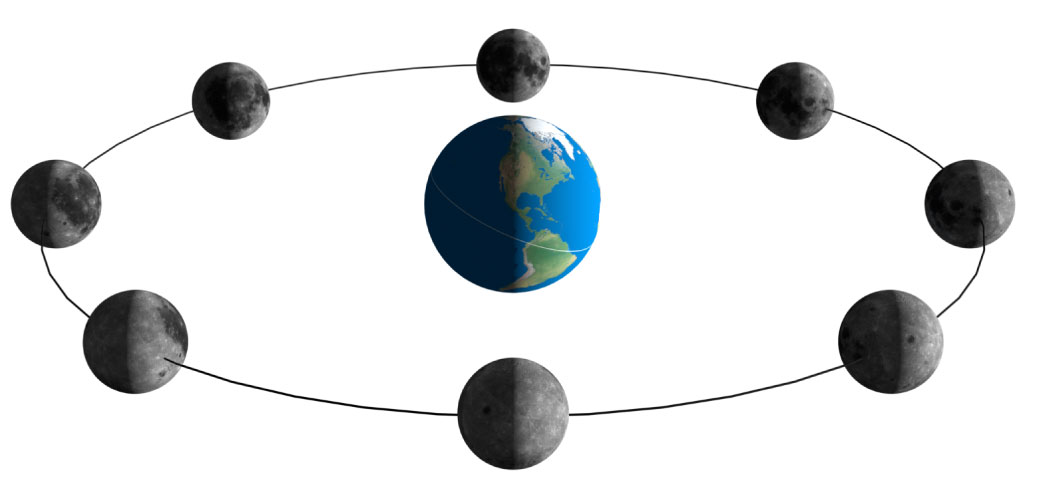
The moon in orbit showing its phases.
The phases of the moon in 2024
Mercury
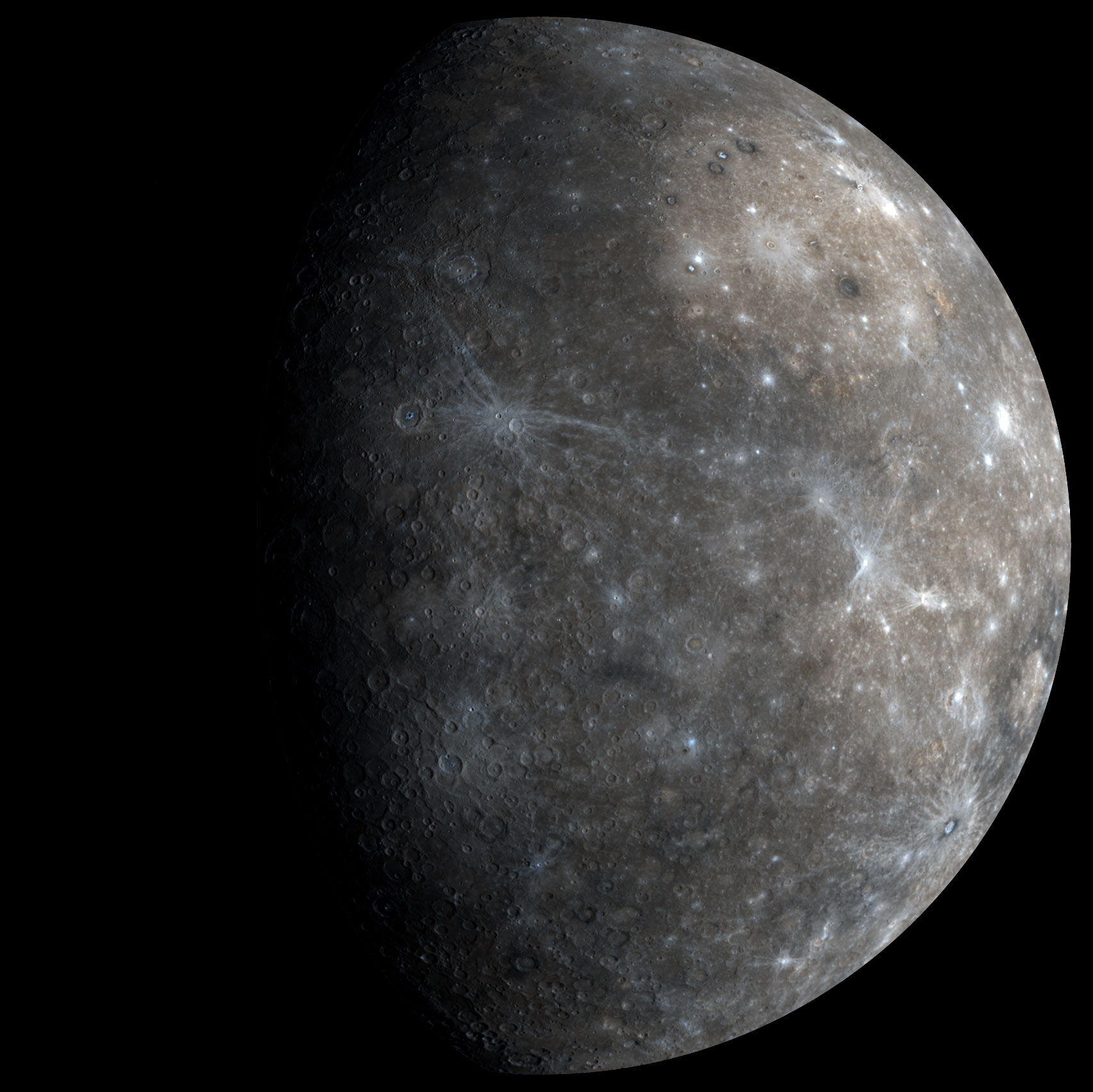
This high-resolution mosaic of WAC images shows Mercury as it appeared to MESSENGER as the spacecraft departed the planet following the mission's first flyby of Mercury.
Credit: NASA/Johns Hopkins University Applied Physics Laboratory/Carnegie Institution of Washington
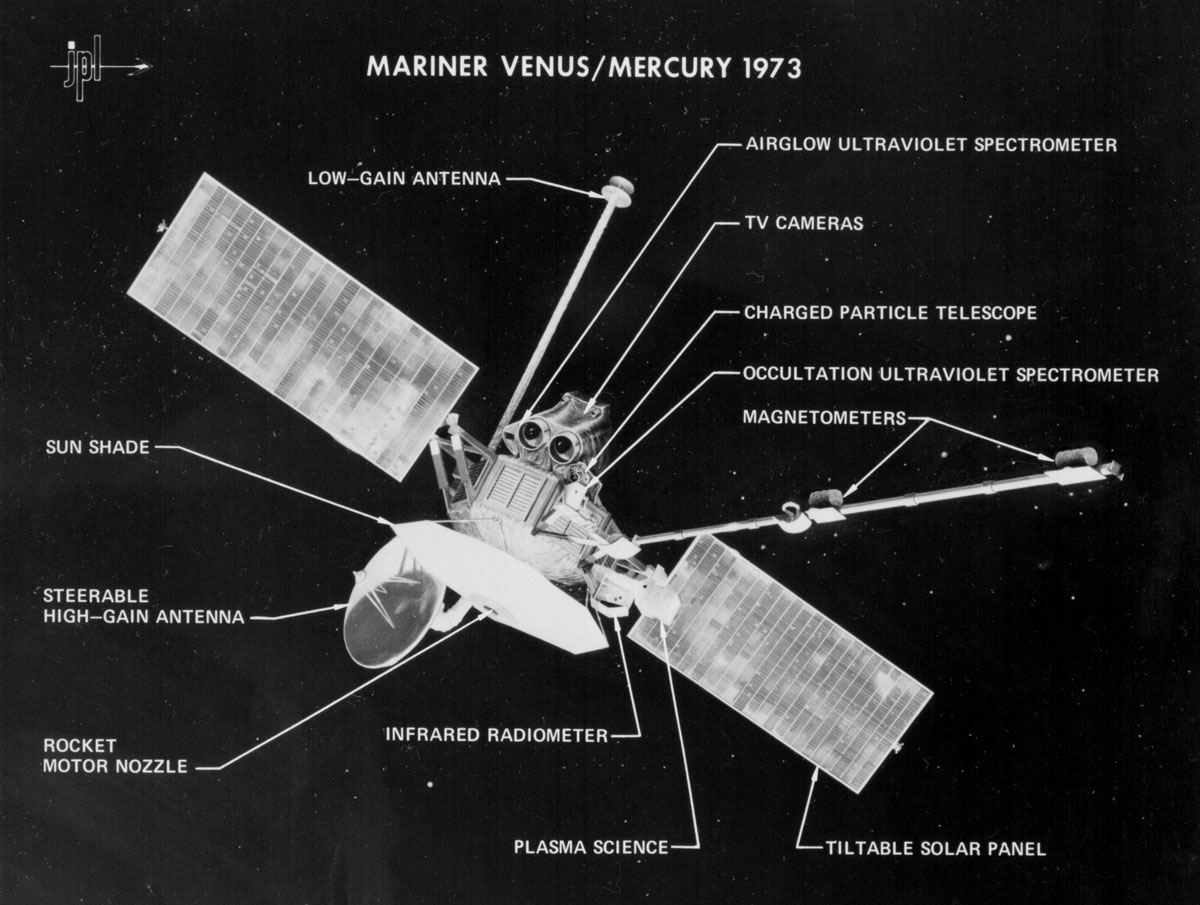
Mariner 10 spacecraft - launched November 3, 1973, Mercury 1st flyby March 1974
By NASA / Jet Propulsion Laboratory - http://solarsystem.nasa.gov/multimedia/display.cfm?IM_ID=1563http://www.nasa.gov/multimedia/imagegallery/image_feature_1483.html, Public Domain, https://commons.wikimedia.org/w/index.php?curid=1182348
The Messenger Mission
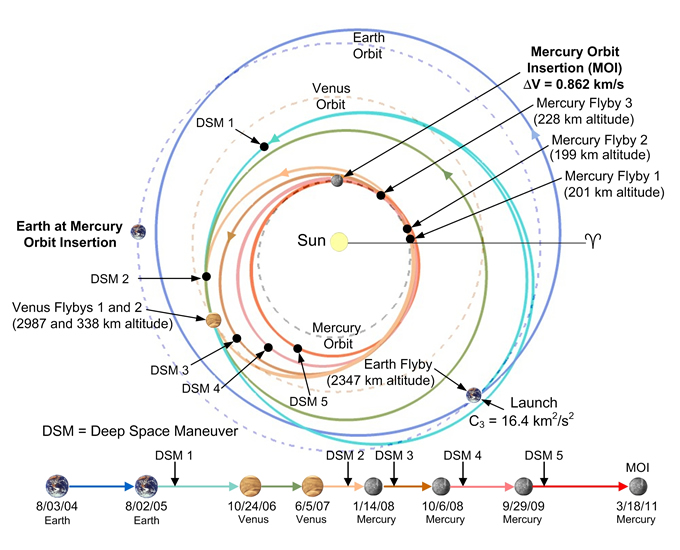
The complicated trajectory to get to Mercury.
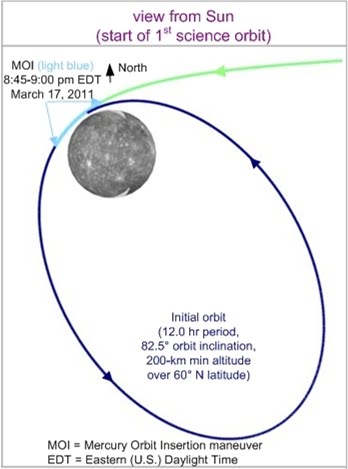
The 1st science orbit
By NASA, Jet Propulsion Laboratory, Applied Physics Laboratory - MESSENGER Website, Public Domain, https://commons.wikimedia.org/w/index.php?curid=15235525
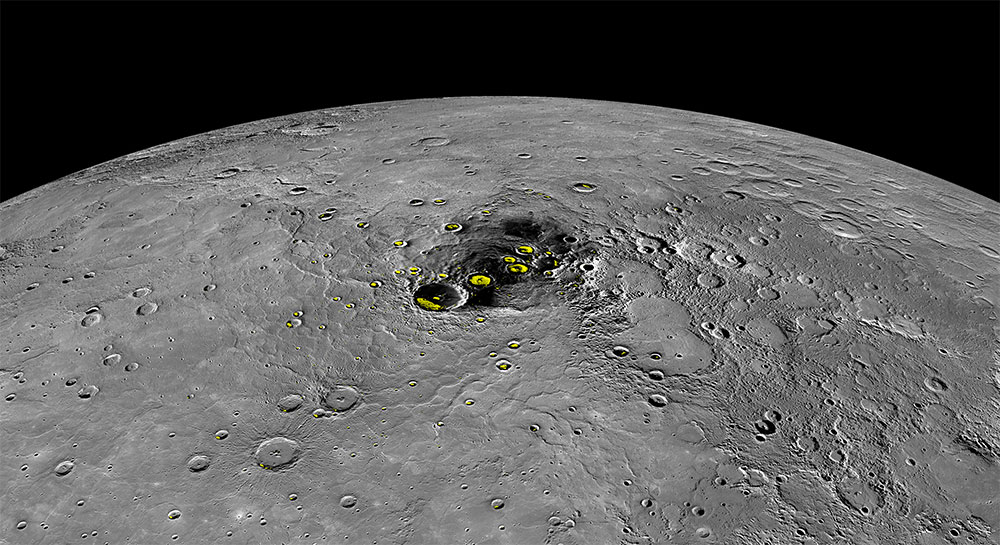
MESSENGER has provided multiple lines of evidence that Mercury’s polar regions host water ice. The permanently shadowed craters near Mercury’s north pole have thermal environments that allow water ice to be stable in these craters either at the surface or a few tens of centimeters below the surface.
NASA/Johns Hopkins University Applied Physics Laboratory/Carnegie Institution of Washington
Mercury - stats
- Atmosphere: None!
- Temperature
- Daytime: 700 K at equatorial noon
- Nighttime: 100K at polar regions
- Interior:
- Little is known (hard to get to)
- Probably has iron-rich interior
- Probably has very thin silicate crust
- Probably has some molten material in core – observed magnetic field is weak
Mercury rotates 3 times during 2 orbits.
| Orbital and Rotational Periods | |
|---|---|
| Orbital Period | 87.969 Earth Days |
| Rotation Period | 58.646 Earth Days |
Venus
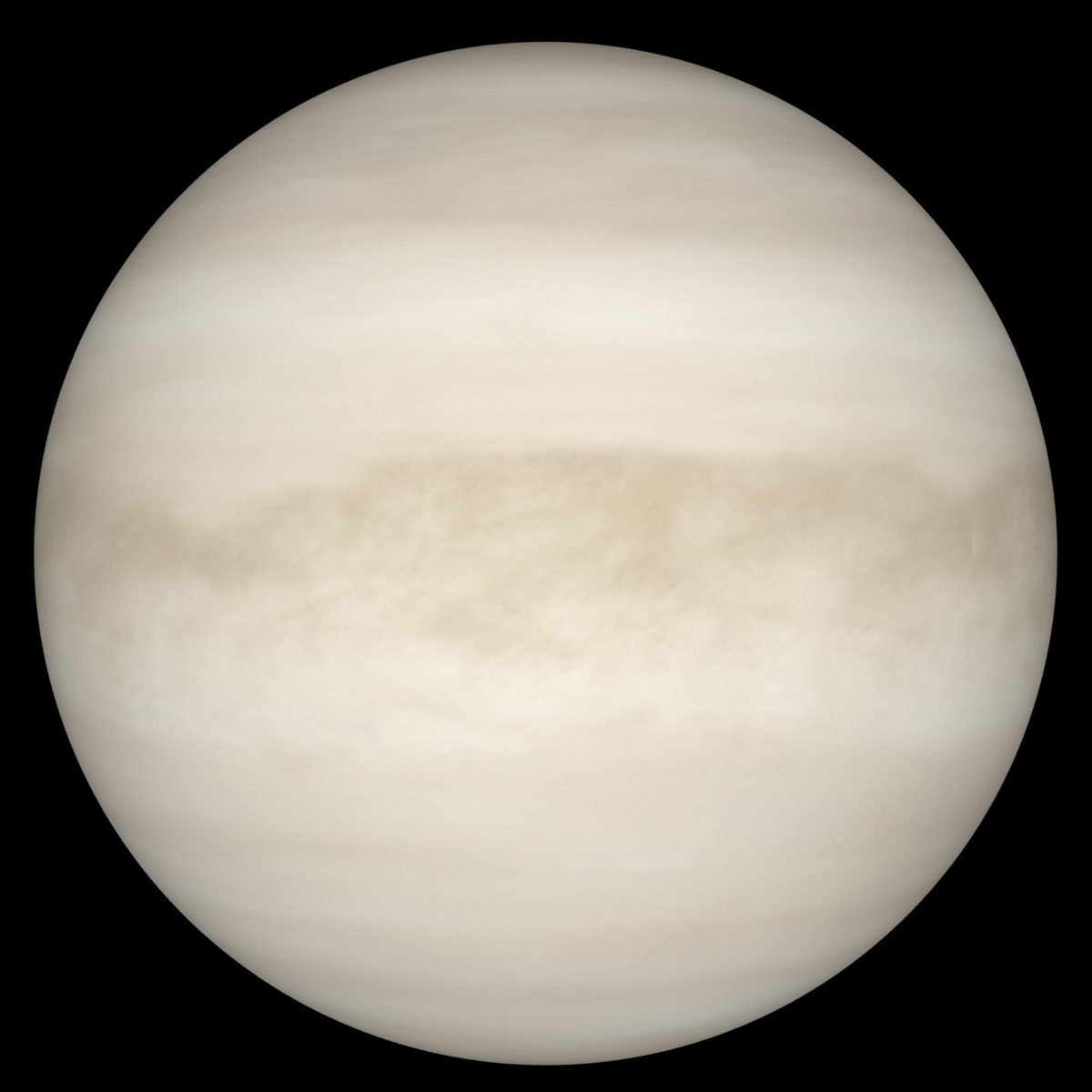
NASA/Goddard Space Flight Center Scientific Visualization Studio.
| Physical Parameters | ||
|---|---|---|
| Mass | $4.867 \times 10^{24} \; \textrm{kg}$ | $0.815 M_\textrm{E}$ |
| Radius | $6,051.8 \; \textrm{km}$ | $0.9499 M_\textrm{E}$ |
| Year | 224.701 days | 0.615 years |
| Rotation | once every 243 Earth days | Clockwise! |
| Eccentricity | 0.006772 | (nearly circular) |
| Magnetic Field | None | (due to slow rotation) |
Greenhouse Effect
A planet is located a distance $D$ away from an energy source.
How hot would a planet be, if it didn't have an atmosphere?
$a$ is the albedo, or how much energy is reflected.
(1 = all of it, 0 = none of it.)
A planet is located a distance $D$ away from an energy source.
The Luminosity of the sun is: $$\begin{equation} L_\textrm{Sun} = 4 \pi R_\textrm{Sun} \sigma_\textrm{SB} T_\textrm{Sun}^4 \end{equation}$$ Now consider a planet a distance $D$ away from the sun. The power received by the planet would just be the ratio of its cross section to a sphere of radius $D$. The energy received per second will be $$\begin{equation} P_\textrm{in} = L_\textrm{Sun} (1-a)\left(\frac{\pi R_p^2}{4 \pi D^2} \right) \end{equation}$$ If the planet radiates as a blackbody, then: $$\begin{equation} P_\textrm{out} = 4 \pi R_p^2 \sigma_\textrm{SB} T_p^4 \end{equation}$$ In thermodynamic equilibrium: $P_\textrm{out} = P_\textrm{in}$
Thus, we can say: $$\begin{equation} L_\textrm{Sun} (1-a)\left(\frac{\pi R_p^2}{4 \pi D^2} \right) = 4 \pi R_p^2 \sigma_\textrm{SB} T_p^4 \end{equation}$$ Solving for $T_p$ $$\begin{equation} T_p = T_\textrm{Sun}(1-a)^{1/4} \sqrt{\frac{R_\textrm{Sun}}{2 D}} \end{equation}$$ Putting number relevant to the Earth and Sun in to this equation, yields a temperature for the earth equal to 255K = -19° C=-1° F. Obviously, we're missing something from this analysis: the greenhouse effect. Take away: the greenhouse effect is real.
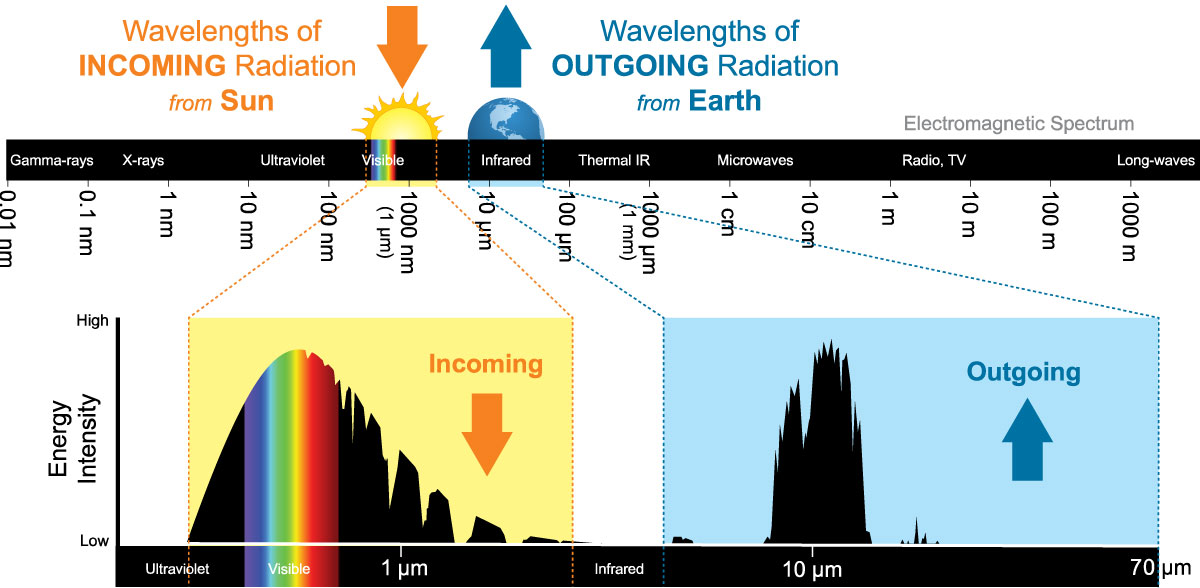
https://www.weather.gov/jetstream/absorb
Venus' Atmosphere
- Top of clouds is 250 K, however, at the surface the temperature is 750 K, above the melting point of Lead.
- Atmospheric Carbon Dioxide prevents outgoing infrared radiation.
- Pressure at the surface is about 90 atm.

The Soviet Union's Venera 14 probe captured two color panoramas of Venus's surface in 1982. This panorama came from the rear camera. Russian Academy of Sciences / Ted Stryk
https://www.planetary.org/space-images/venus-surface-panorama-from-venera-14-camera-2
Venus' Volcanos
- More volcanos than any other object in the solar system. (>1500 major)
- Unclear if they are active or not.
Venera Mission
Mars
Mars, from space. Mosaic of the Valles Marineris hemisphere of Mars projected into point perspective, a view similar to that which one would see from a spacecraft. The distance is 2500 kilometers from the surface of the planet, with the scale being .6km/pixel.
Credit: NASA/JPL-Caltech
| Physical Parameters | ||
|---|---|---|
| Mass | $6.42 \times 10^{23} \; \textrm{kg}$ | $0.107 M_\textrm{E}$ |
| Radius | $3397 \; \textrm{km}$ | $0.533 M_\textrm{E}$ |
| Year | 686.9 days | 1.8807 years |
| Rotation | 24 h 37 min 22.6 s | |
| Eccentricity | 0.0934 | |
| Magnetic Field | Weak | Probably larger in the past |
Mars' Atmosphere
The atmosphere of Mars is mainly composed of carbon dioxide (95 %). It contains only 2 % nitrogen and 0.1–0.4 % oxygen.
The air pressure is only 5–8 mbar. Much has been lost. No greenhouse effect.
Mars' Surface
It's red: Iron Oxide aka rust.
Polar Caps: water ice and CO2
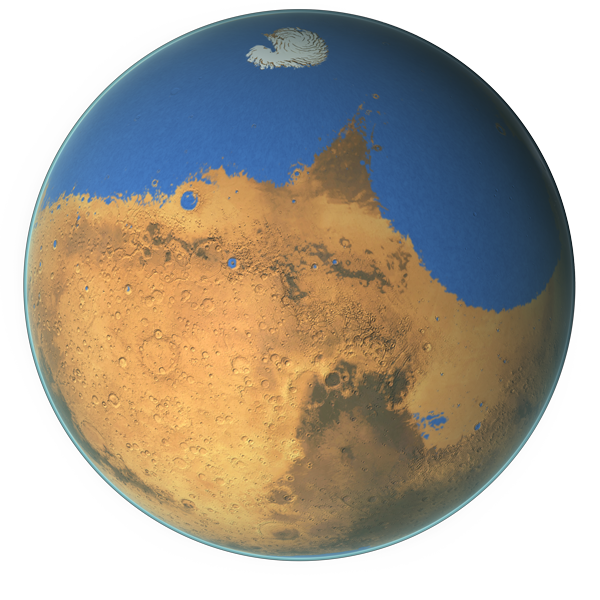
Mars may have had oceans
NASA's Goddard Space Flight Center
Indications are that water has flowed on Mars in the past. Geologic features like river beds and other erosion indicators suggest this. No liquid water has been found on the surface. Too cold and the pressure is too low.
Mars' Moons

Mars' Larger moon Phobos
European Mars Express Mission
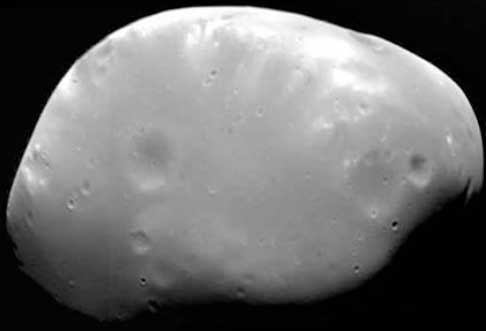
The small moon Deimos
European Mars Express Mission
Two relatively small moons: Phobos and Deimos